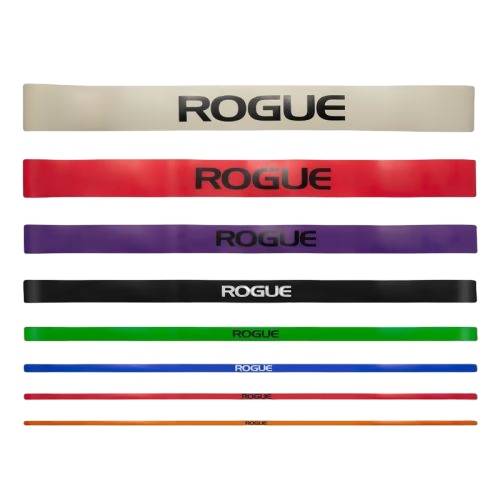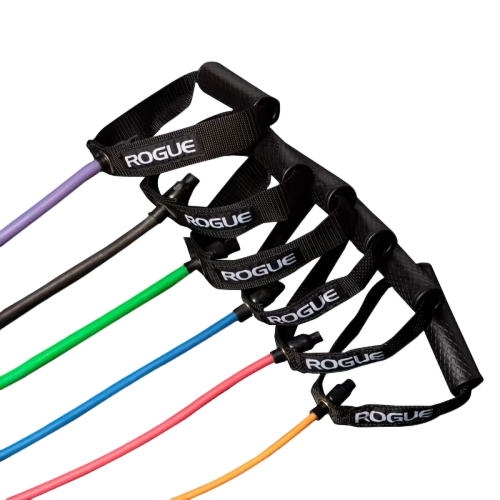Resistance Tubes vs Bands – Which are Better?
When looking at resistance bands vs tubes, they are both versatile workout accessories that can easily be integrated into your gym routine. Resistance bands have exploded over the last decade. They are effective, easily portable, and come at a fraction of the cost of most gym equipment.
Resistance bands and tubes come in different sizes, shapes and are made from different materials.
When comparing braided resistance bands vs regular ones, the difference in design makes them quite easy to tell apart, but resistance tubes and bands are often used interchangeably, differing in their construction and use. I’ll compare the key differences between the two and clear up any confusion you may have regarding the best band option.
Resistance Tubes vs Bands. Resistance tubes and bands vary in shape, resistance, exercise use, portability, price, and handles. Both can be used successfully for a wide range of full-body and accessory exercises.

Which is Better: Loop Resistance Bands or Resistance Tubes with Handles?
Loop resistance bands are a type of fitness accessory made commonly from natural rubber latex, with the flat band shape going around in a continuous loop. Several brands manufacture bands using alternative materials such as polyester to provide a band option for those who have sensitive skin.
Loop resistance bands can be used for a range of strength and conditioning exercises, general rehabilitation, and stretching. Depending on how you use them, they can make exercises harder or easier.
Pros of Loop Resistance Bands
✅ Wider resistance range and max resistance
✅ Offer a range of versatile uses and can easily be attached to gym equipment
✅ Higher-end models tend to be more durable due to their latex layering
✅ The flat design makes them easy to carry around and store
Cons of Loop Resistance Bands
❌ The shape of the bands sometimes leads to an unnatural hand position
❌ Handles can be harder to attach and usually come at an extra cost
Resistance tubes are also made from natural rubber latex, but unlike bands, they come in a hollow tube shape and include handles that are attached to each end. They are suitable for a wide range of full-body and accessory exercises including strength and conditioning, warming up, and stretching.
Pros of Resistance Tubes
✅ Better suited for pulling and pressing movements
✅ Easier to use when on the go or wanted to switch between exercises quickly
✅ The handles allow a more comfortable hand position
✅ Easier to learn as a beginner
Cons of Resistance Tubes
❌ They offer a smaller resistance range compared to bands
❌ Most tubes don’t offer enough resistance for heavier lifting
❌ Harder to attach to gym equipment
❌ Here are the key differences between resistance tubes and bands:
1. Exercises
Perhaps the biggest difference between the two is the exercises you can perform. With the built-in handles and tube design, resistance tubes replicate a dumbbell and cable pulley machine. This makes them better suited for pressing and pushing exercises and pre-exercise warm-ups or alongside compound movements.
Resistance loop bands are generally more versatile and easier to integrate into weight training exercises to make them easier or harder. The loop design means they can move much more freely compared to resistance tubes, making them well suited to compound powerlifting movement, rehabilitation exercises, and general stretching.
2. Comfort and Ease of Use
Whilst both band types are easy to use and provide good comfort when used correctly, the built-in handles on resistance tubes make them easier to grip and keep the hands in a more natural position. The handles also make them more suitable if you’re needing to quickly switch between exercises.
Loop bands tend to be much wider than resistance tubes meaning they distribute the weight over a larger area, putting less pressure on the body. With resistance tubes providing more concentrated pressure, they may be more uncomfortable when placed against the body in certain exercises.
3. Resistance
Maximum resistance refers to how much resistance the band or tube can provide. Whilst resistance tubes commonly go up to 50 lbs, loop bands have a much bigger limit of up to 250 lbs. With this, loop bands also tend to have a much larger resistance range. This makes loop bands better suited to a wider range of lifters and gym exercises for example, powerlifters performing heavy compound movements.
4. Durability
Resistance tubes and bands vary in quality, materials used and construction based on the brand rather than the band type. Resistance tubes are made from a rubber compound containing latex whilst loop bands are made from natural rubber latex, with higher quality ones constructed using continuous flat sheet layers.
If you’re buying mid-range tubes or bands, the durability tends to be similar. Due to the layered latex sheets, resistance loop bands tend to be more durable if purchasing higher-end options.

5. Portability and Storage
Portability and storage refer to how easy the tubes and bands are to move around and store away when not in use. Both types don’t take much space, but loop bands are slightly smaller making them easier to store in tight spaces.
Both types are easily portable but with the smaller band size, resistance loop bands take up slightly less space in a gym bag. Whilst this is a difference between the two, it’s not the main factor when determining which type is the best option.
6. Safety
Both types have limits and will slowly degrade over time. Higher-quality bands tend to last much longer and are less likely to break, making them safer to use.
Higher-quality layered loop bands have a much lower chance of snapping due to the multiple latex layers. This means they are more likely to degrade over time without failing in one use. With tube bands made from a single thick layer, they are much more likely to fail when degraded, even with the built-in snap guards.
7. Shape
The shape of the resistance band is what determines their name and is the most obvious difference between the two types.
Resistance tubes are round, hollow pieces of elastic that make a tubular shape, with most tubes measuring around 1″ in diameter. Resistance loop bands are flat pieces of elastic that are several inches wide and come in a continuous loop. Both shapes offer different benefits which determine the durability and their uses.
8. Handles
Handles can be fitted on both bands and tubes, but they are mainly found attached to resistance tubing in different shapes and styles. Some can be removed easily and others are permanently fixed.
Whilst the wide and flat shape of resistance loop bands makes it harder for handles to be included, they can usually be purchased at extra cost.
8. Price
Price is determined based on the material used, the amount of resistance offered, extra accessories, and the chosen brand.
Loop bands tend to be more cost-effective than tubes, mainly due to their larger resistance range and popularity.
To limit costs, both loop bands and tubes can be purchased in sets or stacked with each other to lower the cost and increase the resistance.

How to Choose the Right Resistance Bands and Tubes
When looking for a set of resistance bands and tubes, both the options below offer great choices that are well-designed and great value for money:
1. Resistance Band Set We Recommend
Rogue produces some of the highest-quality fitness equipment and accessories currently available on the market.
Made from durable latex, the Rogue Echo Resistance Bands offer eight different color-coded resistance levels from 15-200 lbs making them perfect for light conditioning work to heavy-duty powerlifting.
The flat, wide rubber design stops them from bunching up easily like other band options, with the layered latex construction giving you years of use without them wearing down.
The Rogue Echo Resistance bands are 41″ long but also come in ‘shorty’ versions, great for banded exercises that require constant tension using a smaller range of motion.
The bands are available in singles, doubles, and sets such as a ‘pull up assist’ package, and are all branded with the white rogue logo in bold lettering.
2. Resistance Tube Set We Recommend
If you’re looking for a set of durable resistance tubes, the Rogue Tube Bands are our recommended option.
Made from latex-based elastic, each 48″ band features textured grip hands at either end to ensure a strong grip when using them.
They come in six different color-coded resistance options that range from 10-60 lbs and provide incrementally harder resistance as they are stretched.
Available options include single tubes, double tubes, and tube packages such as light, heavy, and the complete package. Like the resistance loop bands, each tube features the rogue branding in the middle.
FAQ
How long do resistance tubes last?
When used and maintained correctly, resistance tubes should last anywhere from years up to a lifetime. Incorrect use and storage will lead to degradation so make sure to bear this in mind.
Are resistance tubes better than weights?
Resistance tubes provide a convenient, cost-effective way to exercise when used on their own or alongside gym equipment and weights.
Both have different uses and should be used alongside one another, meaning tubes aren’t necessarily better or worse than weights
Conclusion
When it comes to the difference between resistance tubes vs bands, the main ones include the shape, exercise options, handles, and ease of use. Both types are easily portable, durable, and available at a fraction of the cost of most gym equipment.
If you’re looking for a pair of tubes or loop bands, consider the products I’ve reviewed above. Both options are high-quality and available in a wide range of band options.
Have you used resistance tubes or loop bands before? What do you think of them? Tell me below!
Also Read:
- Bench Press With Resistance Bands
- Assisted Pull Ups With Resistance Bands
- Resistance Band Deadlift
- Shoulder Stretches With Bands
- Squats With Resistance Bands
- Resistance Band Tricep Workout
- Resistance Band Chest Exercises
References:
- Choosing and Using Resistance Bands // Verywellfit:
https://www.verywellfit.com/choosing-and-using-resistance-bands-1229709 - Durability Of Resistance Bands // Durabilitymatters : https://durabilitymatters.com/resistance-band-maintenance
Why Trust Us?
With over 20 years in Olympic Weightlifting, our team does its best to provide the audience with ultimate support and meet the needs and requirements of advanced athletes and professional lifters, as well as people who strive to open new opportunities and develop their physical capabilities with us.
By trusting the recommendations of our certified experts in coaching, nutrition, dietology, and sports training programming, as well as scientific consultants, and physiotherapists, we provide you with thorough, well-considered, and scientifically proven content. All the information given in the articles concerning workout programming, separate exercises, and athletic performance, in general, is based on verified data. We ensure that you can rely on our professionals’ pieces of advice and recommendations that can be treated as personalized ones which will benefit you and fully meet your needs.
The product testing process is described in more detail here
Author: Tanya Shaiko
News Editor, Olympic Lifting Enthusiast
Best Results: Snatch – 61 kg,
C&J – 78 kg
I’m Tanya, and I just can’t do without fitness. About six years ago, I got into Olympic weightlifting and instantly fell in love with it. Weightlifting is like no other sport – it’s just you versus the bar. Driven by my unwavering passion for an active lifestyle, I’ve been eager to share my personal journey and sports enthusiasm with others. As a journalist and photographer, my interests come full circle, adding an extra dimension to the news column that I curate. This way, I keep my readers updated with the latest happenings in the sports world.









